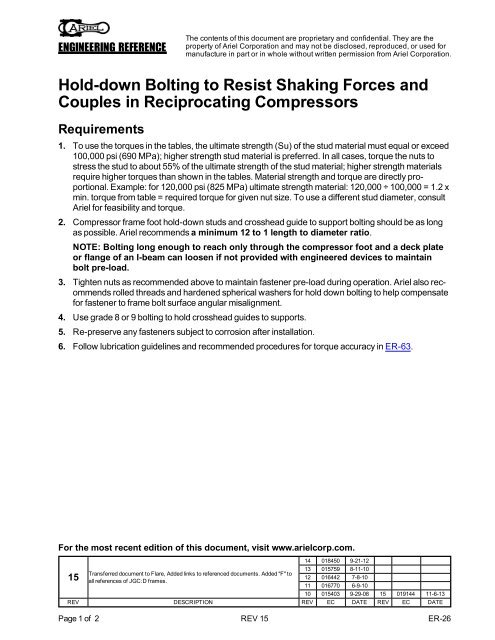Hold-down Bolting to Resist Shaking Forces and ... - Ariel Corporation
Hold-down Bolting to Resist Shaking Forces and ... - Ariel Corporation
Hold-down Bolting to Resist Shaking Forces and ... - Ariel Corporation
- No tags were found...
Create successful ePaper yourself
Turn your PDF publications into a flip-book with our unique Google optimized e-Paper software.
ENGINEERING REFERENCEThe contents of this document are proprietary <strong>and</strong> confidential. They are theproperty of <strong>Ariel</strong> <strong>Corporation</strong> <strong>and</strong> may not be disclosed, reproduced, or used formanufacture in part or in whole without written permission from <strong>Ariel</strong> <strong>Corporation</strong>.<strong>Hold</strong>-<strong>down</strong> <strong>Bolting</strong> <strong>to</strong> <strong>Resist</strong> <strong>Shaking</strong> <strong>Forces</strong> <strong>and</strong>Couples in Reciprocating CompressorsRequirements1. To use the <strong>to</strong>rques in the tables, the ultimate strength (Su) of the stud material must equal or exceed100,000 psi (690 MPa); higher strength stud material is preferred. In all cases, <strong>to</strong>rque the nuts <strong>to</strong>stress the stud <strong>to</strong> about 55% of the ultimate strength of the stud material; higher strength materialsrequire higher <strong>to</strong>rques than shown in the tables. Material strength <strong>and</strong> <strong>to</strong>rque are directly proportional.Example: for 120,000 psi (825 MPa) ultimate strength material: 120,000 ÷ 100,000 = 1.2 xmin. <strong>to</strong>rque from table = required <strong>to</strong>rque for given nut size. To use a different stud diameter, consult<strong>Ariel</strong> for feasibility <strong>and</strong> <strong>to</strong>rque.2. Compressor frame foot hold-<strong>down</strong> studs <strong>and</strong> crosshead guide <strong>to</strong> support bolting should be as longas possible. <strong>Ariel</strong> recommends a minimum 12 <strong>to</strong> 1 length <strong>to</strong> diameter ratio.NOTE: <strong>Bolting</strong> long enough <strong>to</strong> reach only through the compressor foot <strong>and</strong> a deck plateor flange of an I-beam can loosen if not provided with engineered devices <strong>to</strong> maintainbolt pre-load.3. Tighten nuts as recommended above <strong>to</strong> maintain fastener pre-load during operation. <strong>Ariel</strong> also recommendsrolled threads <strong>and</strong> hardened spherical washers for hold <strong>down</strong> bolting <strong>to</strong> help compensatefor fastener <strong>to</strong> frame bolt surface angular misalignment.4. Use grade 8 or 9 bolting <strong>to</strong> hold crosshead guides <strong>to</strong> supports.5. Re-preserve any fasteners subject <strong>to</strong> corrosion after installation.6. Follow lubrication guidelines <strong>and</strong> recommended procedures for <strong>to</strong>rque accuracy in ER-63.For the most recent edition of this document, visit www.arielcorp.com.15Transferred document <strong>to</strong> Flare, Added links <strong>to</strong> referenced documents. Added "F" <strong>to</strong>all references of JGC:D frames.14 018450 9-21-1213 015759 8-11-1012 016442 7-8-1011 016770 6-9-1010 015403 9-29-08 15 019144 11-6-13REV DESCRIPTION REV EC DATE REV EC DATEPage 1 of 2 REV 15 ER-26
ENGINEERING REFERENCEThe contents of this document are proprietary <strong>and</strong> confidential. They are theproperty of <strong>Ariel</strong> <strong>Corporation</strong> <strong>and</strong> may not be disclosed, reproduced, or used formanufacture in part or in whole without written permission from <strong>Ariel</strong> <strong>Corporation</strong>.TABLE 1 <strong>Hold</strong>-<strong>down</strong> <strong>Bolting</strong> - Minimum Torques aCompressorModelHole Diameterinch (mm)Frame FootRecommendedStud Sizeinch--TPIMinimum NutTorque clb-ft (N•m)Crosshead Guide <strong>to</strong> Support b<strong>Bolting</strong> Sizeinch--TPI<strong>Bolting</strong> Torquelb-ft (N•m)JGI 7/8 (22) 3/4--10 175 (235) --- ---JGM:N:P:Q 3/4 (19) 5/8--11 100 (130) 5/8--11 90 (120)JG:A 7/8 (22) 3/4--10 175 (235) 5/8--11 90 (120)ACF d , JGR:J 1 (25) 7/8--9 280 (380) 3/4--10 160 (215)JGW 1 (25) 7/8--9 280 (380) 5/8--11 90 (120)JGH:E 1-1/4 (32) 1-1/8--7 600 (805) 7/8--9 255 (345)JGK:T e 1-1/4 (32) 1-1/8--7 600 (805) 1--8 380 (515)JGC:D:F 1-1/2 (48) 1-3/8--6 1100 (1500) 1-1/4--7 765 (1040)JGZ:U 1-7/8 (48) 1-3/4--5 2300 (3100) 1-1/4--7 765 (1040)KBZ:U 1-7/8 (48) 1-3/4--5 2300 (3100) 1-1/4--12 780 (1055)JGB:V, KBB:V 1-7/8 (48) 1-3/4--5 2300 (3100) 1-1/2--6 1340 (1815)a. See #1, "Requirements".b. Not applicable <strong>to</strong> directly-opposed compressors.c. When using a stud pitch other than those listed above in the same nominal diameter size, use this formula <strong>to</strong> determinerequired <strong>to</strong>rque: Torque = (TABLE 1 fastener <strong>to</strong>rque) x (target fastener root area ÷ TABLE 1 fastener rootarea).d. For directly-opposed compressors, use frame foot values.e. For JGT compressors with ET crosshead guides, use the 7/8”–9 TPI bolting size in TABLE 1 as a minimum <strong>to</strong>rque <strong>to</strong>bolt the crosshead guide <strong>to</strong> the support.TABLE 2 Crosshead Guide Support Foot <strong>Hold</strong>-<strong>down</strong> <strong>Bolting</strong> - Minimum Torques aCompressor ModelJGM:N:P:Q:IHole Diameterinch (mm)Recommended StudSize, inch--TPIN/AMinimum Nut Torque b lbft(N•m)JG:A 3/4 (19) 5/8--11 100 (130)JGR:J:W 1 (25) 7/8--9 280 (380)JGH:EK:T 1-1/4 (32) 1-1/8--7 600 (805)JGC:D:F:Z:U 1-1/2 (38) 1-3/8--6 1100 (1500)JGB:V, KBB:V:Z:U 1-7/8 (48) 1-3/4--5 2300 (3100)a. See #1, "Requirements".b. When using a stud pitch other than those listed above in the same nominal diameter size, use this formula <strong>to</strong> determinerequired <strong>to</strong>rque: Torque = (TABLE 2 fastener <strong>to</strong>rque) x (target fastener root area ÷ TABLE 2 fastener rootarea).Page 2 of 2 REV 15 ER-26















